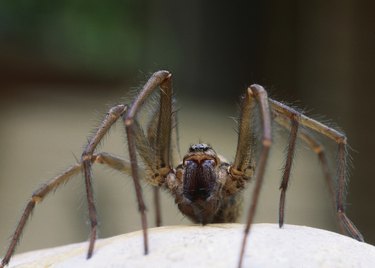
You don't have to suffer from arachnophobia to feel at least a little uneasy around the eight-legged denizens of the world. Spiders are often a source of fear and discomfort for people. However, the vast majority of Kansas spiders are not dangerous to humans. Of roughly 500 different types of spiders in Kansas, however, there are some species whose venomous bites are potentially dangerous to all mammals, including you.
Venomous Types of Spiders in Kansas
Video of the Day
Technically, there are plenty of "venomous" animals around with the ability to inject toxins via a bite or sting, including some spiders. "Poisonous" refers to a substance that a person would ingest, such as swallowing a toxic material, so there aren't "poisonous" spiders in Kansas per se.
Video of the Day
All spiders are venomous, as this is how they kill their prey. However, the fangs of most spiders are too small or fragile to pierce human skin, rendering them totally harmless to us. Only three Kansas species of these arachnids should concern you: the brown recluse, the yellow sac spider, and the infamous black widow.
Brown Recluse Spider
One of the more common venomous types of spiders in Kansas, the brown recluse has a notoriously wicked bite. This animal's venom can cause significant pain in people who are bitten. The venom of the brown recluse can cause skin damage, including tissue loss and necrosis. These spiders usually have a body length between 1/4 and 3/4 inch. The brown recluse spider has a dark, violin-shaped mark on its cephalothorax (back). The violin's neck points to the spider's abdomen (rear).
Brown recluse spiders are very common in Kansas year-round and are often found indoors, sometimes in large numbers. Empty shoes are particularly attractive hiding places for this arachnid, so be sure to shake them out before you put them on. These spiders are common household denizens, though their threat to humans is minimal.
Black Widow Spider
One of the most widely known and feared spider species, the black widow is one of the relatively few spider species that can be deadly to humans. Fortunately, this spider is easily identifiable, having a distinctive black body with a red hourglass shape on the underside of the abdomen. A quick look at pictures of black spiders in Kansas will prove this one easy to recognize and avoid.
This potentially dangerous spider's presence in Kansas is limited, with the southern black widow spider sometimes found in the south or southeastern parts of the state, though it is not common. Active mostly at night, these arachnids can most often be found in barns, carports, sheds and other outdoor structures, but the sometimes frigid Kansas winters can drive them indoors. The black widow is so named because the female of the species has the quaint habit of eating her husband after they have mated.
Yellow Sac Spider
One of the more common spiders found in the United States, the yellow sac spider (or yellow sack spider) has powerful fangs that allow it to pierce the skin of humans. These small Kansas spiders are common throughout the state and can be found year-round. They're especially fond of indoor environments where temperatures remain stable enough for them to breed.
Female yellow sac spiders in Kansas tend to lay their egg sacs in October, with the spiderlings emerging in the spring. These spiders tend to be of a yellowish, tan, or even greenish color and can often be quite pale. They have longer front legs when compared to their other pairs of legs and build funnellike structures instead of webs. Their bite can be painful, though usually not dangerous.